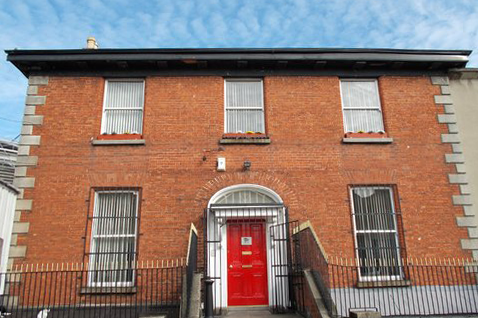In this issue of the INOU e-bulletin, author Michael Quinn writes about his work on the history of Araby House, the INOU’s premises on North Richmond Street in Dublin’s north inner city.
Thanks to the support of my former colleagues and friends at the INOU, and a grant from Dublin City Council's cultural committee (with the assistance of the former Lord Mayor, Councillor Nial Ring), my ambition to publish a social history of Araby House and its environs has come to fruition. Entitled A History of Araby House and North Richmond Street, Dublin, 1820-1998, the organisation has recently published the history in booklet form, beautifully designed and printed by Cormac O'Hanrahan of Printwell Design – complete with an evocative front cover photograph taken in 1946 by the celebrated American photojournalist Lee Miller.
During my three happy years working with the INOU as a finance administrator, while climbing the granite steps to enter through the (original) hall door of Araby House, I was often struck by a sense of history about the house and its environs. My appreciation of its attractive, sturdy, well-lived-in presence soon gave way to a curiosity about its past - questions about its origin, about its part in the great sweep of historical events that have occurred since it was built, but mostly about the people who lived and worked here came flooding into my mind.
As I pondered such questions, my eye was drawn back along North Richmond Street's two terraces of fine houses that gaze steadily upon one another, and further questions arose about their past and relationship to Araby House. What changes has the wear and tear of history wrought upon these homes? What kind of people lived along this street, and in what numbers and conditions? Who among them, women as well as men, stand out for making contributions to the cultural and political heritage of Dublin City and beyond? Who among them have been forgotten by history?
My study takes a chronological, evidence-based approach, and combines its findings from primary sources such as official directories, state archives and census returns with information drawn from the first drafts of history – newspaper records. The booklet is also informed by a wealth of research already published by recognised authors. Mindful that for many readers Irish history is better known through literature than historical writing, it blends in some examples of fictional writing from James Joyce who lived for a time on the street and incorporated a unique record of its people and ambience into his books. Araby House was so named by the INOU in honour of Joyce’s short story Araby which was included in his collection of short stories, Dubliners.
I have ordered the work into four chapters corresponding to distinct phases of the house's evolution. Chapter 1 commences in the 1820s with the development of the other houses along the street and the later building of Araby House (No. 8), and introduces its first owner and his extensive business and landlord interests. Chapter 2 proceeds to No. 8's next inhabitants, a family of grocers; and then to No. 13 to discuss the quixotic Joyce family who lived there in the 1890s. The third chapter reveals a fundamental change in the status of the house and gardens, and continues with an account of the Byrne family in No. 17, who played a gallant part in the 1916 Easter Rising and subsequent War of Independence. The final chapter traces the transformation of No. 8 and its surroundings into a commercial centre which, in turn, hosted an agricultural society; one of Dublin's oldest light engineering works, Thomas Pearson and Co.; and, lastly, an industrial estate – all before the arrival of the INOU in 1998.
